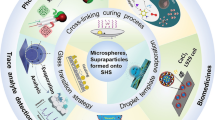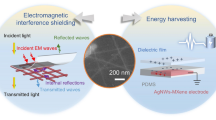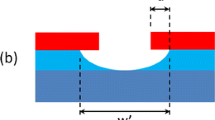Abstract
Nanopore fabrication via the controlled dielectric breakdown (CDB) method offers an opportunity to create solid-state nanopores directly in salt solution with sub-nanometer precision. Driven by trap assisted current tunneling, the method uses localized defects, or traps, in the dielectric material to isolate a breakdown point and fabricate a single pore in less than 10 minutes. Here we present an approach to controlled dielectric breakdown of SiNx in which the nanopore is fabricated in LiCl buffer instead of the traditional KCl buffer. Direct fabrication in LiCl buffer promotes a uniform, symmetric, cylindrical nanopore structure that is fully wet and can be used for experiments in situ. We have shown that fabrication in LiCl reduces the necessity for overnight pore stabilization and allows for the desired analyte to be added in significantly less time than it would take if fabrication was performed in KCl. Pores created by this approach can be used for biosensing applications, including the detection of double-stranded DNA. DNA translocation experiments were conducted in both LiCl and KCl buffer. Experiments conducted in LiCl buffer resulted in about a 2-fold increase in dsDNA transport duration when compared to experiments conducted in KCl buffer of the same concentration. An increase in transport duration of over 10-fold in comparison to KCl was observed when the concentration of the LiCl buffer was increased by a factor of 3.





Similar content being viewed by others
References
T.C. Autumn, B. Kyle, R.H. Adam, T.-C. Vincent, Solid-state nanopore localization by controlled breakdown of selectively thinned membranes. Nanotechnology 28(8), 085304 (2017)
E. Beamish, H. Kwok, V. Tabard-Cossa, M. Godin, Fine-tuning the Size and Minimizing the Noise of Solid-state Nanopores. J. Visual. Exp.: JoVE 80, 51081 (2013)
S. Beckert, F. Stallmach, Water dynamics of LiCl solutions confined in nanopores. Diff. Fund. 18(13), 1–4 (2013)
J. Bello, Y.-R. Kim, S.M. Kim, T.-J. Jeon, J. Shim, Lipid bilayer membrane technologies: A review on single-molecule studies of DNA sequencing by using membrane nanopores. Microchim. Acta 184(7), 1883–1897 (2017)
M. Bestetti, Contribution to the study of uniform corrosion by means of the maximum entropy production rate principle. Prot. Metal. Phys. Chem. Surf. 52(1), 176–181 (2016)
D. Branton, D.W. Deamer, A. Marziali, H. Bayley, S.A. Benner, T. Butler, M. Di Ventra, S. Garaj, A. Hibbs, X. Huang, S.B. Jovanovich, P.S. Krstic, S. Lindsay, X.S. Ling, C.H. Mastrangelo, A. Meller, J.S. Oliver, Y.V. Pershin, J.M. Ramsey, R. Riehn, G.V. Soni, V. Tabard-Cossa, M. Wanunu, M. Wiggin, J.A. Schloss, The potential and challenges of nanopore sequencing. Nat. Biotech. 26(10), 1146–1153 (2008)
K. Briggs, H. Kwok, V. Tabard-Cossa, Automated Fabrication of 2-nm Solid-State Nanopores for Nucleic Acid Analysis. Small 10(10), 2077–2086 (2014)
P.M. Das, R. Singal, DNA Methylation and Cancer. J. Clin. Oncol. 22(22), 4632–4642 (2004)
B. Eric, K. Harold, T.-C. Vincent, G. Michel, Precise control of the size and noise of solid-state nanopores using high electric fields. Nanotechnology 23(40), 405301 (2012)
D. Fologea, J. Uplinger, B. Thomas, D.S. McNabb, J. Li, Slowing DNA Translocation in a Solid-State Nanopore. Nano Lett. 5(9), 1734–1737 (2005)
G.S. Frankel, N. Sridhar, Understanding localized corrosion. Mater. Today 11(10), 38–44 (2008)
A.Y. Grosberg, Y. Rabin, DNA capture into a nanopore: interplay of diffusion and electrohydrodynamics. J. Chem. Phys. 133(16), 165102 (2010)
S. Habermehl, R.T. Apodaca, R.J. Kaplar, On dielectric breakdown in silicon-rich silicon nitride thin films. Appl. Phys. Lett. 94(1), 012905 (2009)
Y. He, M. Tsutsui, R.H. Scheicher, C. Fan, M. Taniguchi, T. Kawai, Mechanism of how salt-gradient-induced charges affect the translocation of DNA molecules through a nanopore. Biophys. J. 105(3), 776–782 (2013)
D.S. Jeong, C.S. Hwang, Tunneling-assisted Poole-Frenkel conduction mechanism in HfO2 thin films. J. Appl. Phys. 98(11), 113701 (2005)
J. Kasianowicz, E. Brandin, D. Branton, D.W. Deamer, Characterization of individual polynucleotide molecules using a membrane channel. Proc. Natl. Acad. Sci. U. S. A. 93, 13770–13773 (1996)
J.J. Kasianowicz, J.W. Robertson, E.R. Chan, J.E. Reiner, V.M. Stanford, Nanoscopic porous sensors. Ann. Rev. Anal. Chem. (Palo Alto, Calif.) 1, 737–766 (2008)
S.W. Kowalczyk, A.R. Hall, C. Dekker, Detection of Local Protein Structures along DNA Using Solid-State Nanopores. Nano Lett. 10(1), 324–328 (2010)
S.W. Kowalczyk, Y.G. Alexander, R. Yitzhak, D. Cees, Modeling the conductance and DNA blockade of solid-state nanopores. Nanotechnology 22(31), 315101 (2011)
S.W. Kowalczyk, D.B. Wells, A. Aksimentiev, C. Dekker, Slowing down DNA Translocation through a Nanopore in Lithium Chloride. Nano Lett. 12(2), 1038–1044 (2012)
O.V. Krasilnikov, R.Z. Sabirov, V.I. Ternovsky, P.G. Merzliak, B.A. Tashmukhamedov, The structure of Staphylococcus aureus alpha-toxin-induced ionic channel. Gen. Physiol. Biophys. 7(5), 467–473 (1988)
O.V. Krasilnikov, R.Z. Sabirov, V.I. Ternovsky, P.G. Merzliak, J.N. Muratkhodjaev, A simple method for the determination of the pore radius of ion channels in planar lipid bilayer membranes. FEMS Microbiol. Lett. 105(1–3), 93–100 (1992)
P. Krishnakumar, B. Gyarfas, W. Song, S. Sen, P. Zhang, P. Krstić, S. Lindsay, Slowing DNA Translocation through a Nanopore Using a Functionalized Electrode. ACS Nano 7(11), 10319–10326 (2013)
H. Kwok, K. Briggs, V. Tabard-Cossa, Nanopore Fabrication by Controlled Dielectric Breakdown. PLoS One 9(3), e92880 (2014)
B. Kyle, C. Martin, K. Harold, L. Timothea, C. Sanmeet, B. José, W. Matthew, T.-C. Vincent, Kinetics of nanopore fabrication during controlled breakdown of dielectric membranes in solution. Nanotechnology 26(8), 084004 (2015)
Z. Liang, Z. Tang, J. Li, R. Hu, D. Yu, Q. Zhao, Interaction prolonged DNA translocation through solid-state nanopores. Nano 7(24), 10752–10759 (2015)
D.-H. Lin, C.-Y. Lin, S. Tseng, J.-P. Hsu, Influence of electroosmotic flow on the ionic current rectification in a pH-regulated, conical nanopore. Nano 7(33), 14023–14031 (2015)
S. Lombardo, J.H. Stathis, B.P. Linder, K.L. Pey, F. Palumbo, C.H. Tung, Dielectric breakdown mechanisms in gate oxides. J. Appl. Phys. 98(12), 121301 (2005)
E.C. Lopes, E. Valls, M.E. Figueroa, A. Mazur, F.G. Meng, G. Chiosis, P.W. Laird, N. Schreiber-Agus, J.M. Greally, E. Prokhortchouk, A. Melnick, Kaiso contributes to DNA methylation-dependent silencing of tumor suppressor genes in colon cancer cell lines. Cancer Res. 68(18), 7258–7263 (2008)
M. Mao, J.D. Sherwood, S. Ghosal, Electro-osmotic flow through a nanopore. J. Fluid Mech. 749, 167–183 (2014)
M.M. Marshall, J.A. Ruzicka, E.W. Taylor, A.R. Hall, Detecting DNA Depurination with Solid-State Nanopores. PLoS One 9(7), e101632 (2014)
D.V. Melnikov, Z.K. Hulings, M.E. Gracheva, Electro-osmotic flow through nanopores in thin and ultrathin membranes. Phys. Rev. E 95(6), 063105 (2017)
F. Nicoli, D. Verschueren, M. Klein, C. Dekker, M.P. Jonsson, DNA translocations through solid-state plasmonic nanopores. Nano Lett. 14(12), 6917–6925 (2014)
C. Plesa, D. Verschueren, S. Pud, J. van der Torre, J.W. Ruitenberg, M.J. Witteveen, M.P. Jonsson, A.Y. Grosberg, Y. Rabin, C. Dekker, Direct observation of DNA knots using a solid-state nanopore. Nat. Nano. 11(12), 1093–1097 (2016)
S. Pud, D. Verschueren, N. Vukovic, C. Plesa, M.P. Jonsson, C. Dekker, Self-Aligned Plasmonic Nanopores by Optically Controlled Dielectric Breakdown. Nano Lett. 15(10), 7112–7117 (2015)
J.E. Reiner, J.J. Kasianowicz, B.J. Nablo, J.W.F. Robertson, Theory for polymer analysis using nanopore-based single-molecule mass spectrometry. Proc. Natl. Acad. Sci. U. S. A. 107(27), 12080–12085 (2010)
K.D. Robertson, DNA methylation and human disease. Nat. Rev. Genet. 6(8), 597–610 (2005)
M.R. Rountree, K.E. Bachman, J.G. Herman, S.B. Baylin, DNA methylation, chromatin inheritance, and cancer. Oncogene 20(24), 3156–3165 (2001)
T.V.S.L. Satyavani, B. Ramya Kiran, V. Rajesh Kumar, A. Srinivas Kumar, S.V. Naidu, Effect of particle size on dc conductivity, activation energy and diffusion coefficient of lithium iron phosphate in Li-ion cells. Eng. Sci. Technol. , Int. J. 19(1), 40–44 (2016)
B. Schiedt, K. Healy, A.P. Morrison, R. Neumann, Z. Siwy, Transport of ions and biomolecules through single asymmetric nanopores in polymer films. Nucl. Instrum. Methods Phys. Res., Sect. B 236(1), 109–116 (2005)
J. Shim, G.I. Humphreys, B.M. Venkatesan, J.M. Munz, X. Zou, C. Sathe, K. Schulten, F. Kosari, A.M. Nardulli, G. Vasmatzis, R. Bashir, Detection and Quantification of Methylation in DNA using Solid-State Nanopores. Sci. Rep. 3, 1389 (2013)
J. Shim, Y. Kim, G.I. Humphreys, A.M. Nardulli, F. Kosari, G. Vasmatzis, W.R. Taylor, D.A. Ahlquist, S. Myong, R. Bashir, Nanopore-Based Assay for Detection of Methylation in Double-Stranded DNA Fragments. ACS Nano 9(1), 290–300 (2015)
J. Shim, S. Banerjee, H. Qiu, K.K.H. Smithe, D. Estrada, J. Bello, E. Pop, K. Schulten, R. Bashir, Detection of methylation on dsDNA using nanopores in a MoS2 membrane. Nano (2017)
K.P. Singh, M. Kumar, Effect of surface charge density and electro-osmotic flow on ionic current in a bipolar nanopore fluidic diode. J. Appl. Phys. 110(8), 084322 (2011)
Z.S. Siwy, Ion-Current Rectification in Nanopores and Nanotubes with Broken Symmetry. Adv. Funct. Mater. 16(6), 735–746 (2006)
R.M.M. Smeets, U.F. Keyser, D. Krapf, M.-Y. Wu, N.H. Dekker, C. Dekker, Salt Dependence of Ion Transport and DNA Translocation through Solid-State Nanopores. Nano Lett. 6(1), 89–95 (2006)
E. Stellwagen, Q. Dong, N.C. Stellwagen, Monovalent cations affect the free solution mobility of DNA by perturbing the hydrogen-bonded structure of water. Biopolymers 78(2), 62–68 (2005)
A.J. Storm, C. Storm, J. Chen, H. Zandbergen, J.-F. Joanny, C. Dekker, Fast DNA Translocation through a Solid-State Nanopore. Nano Lett. 5(7), 1193–1197 (2005)
G. Strathdee, R. Brown, Aberrant DNA methylation in cancer: potential clinical interventions. Expert Rev. Mol. Med. 4(4), 1–17 (2002)
B.M. Venkatesan, R. Bashir, Nanopore sensors for nucleic acid analysis. Nat. Nanotechnol. 6(10), 615–624 (2011)
I. Vodyanoy, S.M. Bezrukov, Sizing of an ion pore by access resistance measurements. Biophys. J. 62(1), 10–11 (1992)
Y. Wang, C. Ying, W. Zhou, L. de Vreede, Z. Liu, J. Tian, Fabrication of multiple nanopores in a SiNx membrane via controlled breakdown. Sci. Rep. 8(1), 1234 (2018)
M. Wanunu, W. Morrison, Y. Rabin, A.Y. Grosberg, A. Meller, Electrostatic focusing of unlabelled DNA into nanoscale pores using a salt gradient. Nat. Nano. 5(2), 160–165 (2010)
M. Waugh, A. Carlsen, D. Sean, G.W. Slater, K. Briggs, H. Kwok, V. Tabard-Cossa, Interfacing solid-state nanopores with gel media to slow DNA translocations. Electrophoresis 36(15), 1759–1767 (2015)
Weast, R. C., CRC Handbook of Chemistry and Physics, 70th Edition. Taylor & Francis: 1989
R.W. Wilson, D.C. Rau, V.A. Bloomfield, Comparison of polyelectrolyte theories of the binding of cations to DNA. Biophys. J. 30(2), 317–325 (1980)
Wolf, A. V., Aqueous solutions and body fluids: their concentrative properties and conversion tables. Hoeber Medical Division, Harper & Row: 1966
Wu, J.; Register, L. F.; Rosenbaum, E. In Trap-assisted tunneling current through ultra-thin oxide, 1999 I.E. International Reliability Physics Symposium Proceedings. 37th Annual (Cat. No.99CH36296), 1999; pp 389–395
I. Yanagi, R. Akahori, T. Hatano, K.-I. Takeda, Fabricating nanopores with diameters of sub-1 nm to 3 nm using multilevel pulse-voltage injection. Sci. Rep. 4, 5000 (2014)
E.C. Yusko, J.M. Johnson, S. Majd, P. Prangkio, R.C. Rollings, J. Li, J. Yang, M. Mayer, Controlling protein translocation through nanopores with bio-inspired fluid walls. Nat. Nano. 6(4), 253–260 (2011)
O.K. Zahid, B.S. Zhao, C. He, A.R. Hall, Quantifying mammalian genomic DNA hydroxymethylcytosine content using solid-state nanopores. Sci. Rep. 6, 29565 (2016)
J. Zhi, Z. Yi-Qi, L. Cong, W. Ping, L. Yu-Qi, Influence of trap-assisted tunneling on trap-assisted tunneling current in double gate tunnel field-effect transistor. Chin. Phys. B. 25(2), 027701 (2016)
Acknowledgements
This work was supported by Rowan University Startup fund.
We thank Maksudul Mowla, Undergraduate Research Assistant, and Liza Guner, Summer Research Intern, for their assistance in data acquisition and analysis.
Author information
Authors and Affiliations
Corresponding author
Electronic supplementary material
ESM 1
(DOCX 250 kb)
Rights and permissions
About this article
Cite this article
Bello, J., Shim, J. Solid-state nanopore fabrication in LiCl by controlled dielectric breakdown. Biomed Microdevices 20, 38 (2018). https://doi.org/10.1007/s10544-018-0281-9
Published:
DOI: https://doi.org/10.1007/s10544-018-0281-9




